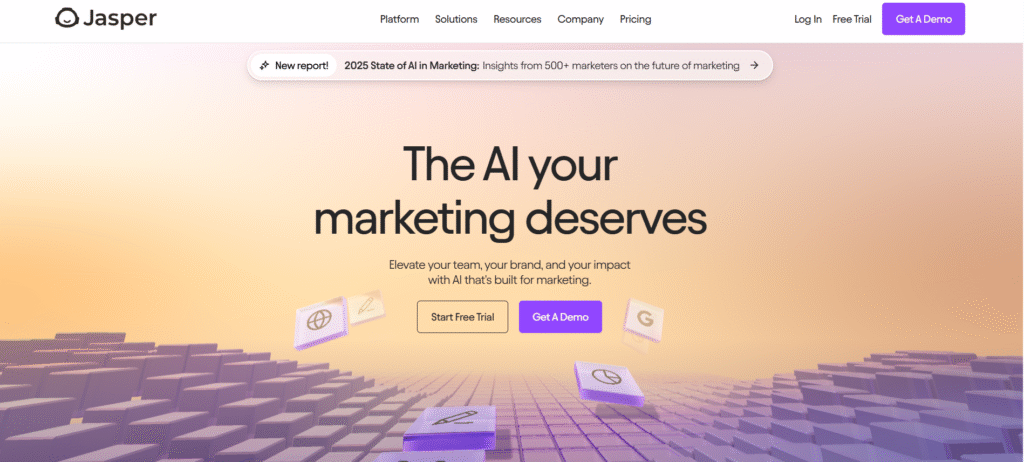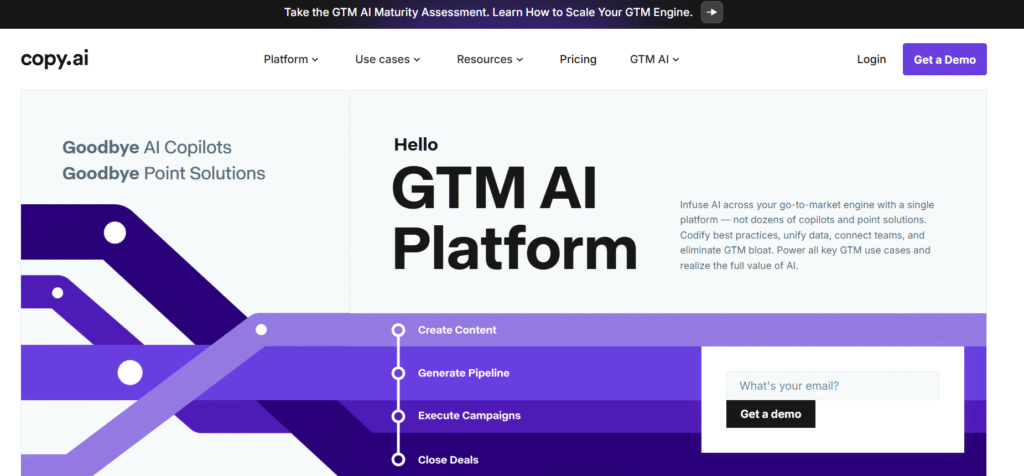Best AI Writing Software in 2025
AI writing tools are designed to save time, enhance creativity, and improve the quality of written content. They can:
- Generate ideas and outlines for blogs, stories, or reports.
- Produce polished drafts in seconds.
- Optimize content for SEO or specific audiences.
- Edit for grammar, clarity, and tone.
- Translate text or adapt it for different formats.
With applications across industries—marketing, education, publishing, and more—these tools are indispensable for anyone looking to scale their writing efforts. However, not all AI writing software is created equal. Below, we dive into the top contenders, based on usability, features, pricing, and real-world performance.
1. Jasper AI

Jasper AI remains a heavyweight in the AI writing space, known for its versatility and robust feature set. It’s particularly popular among marketers and content creators for generating blog posts, ad copy, and social media content.
Key Features
- Templates: Over 50 templates for emails, product descriptions, landing pages, and more.
- Brand Voice: Customizes output to match your brand’s tone and style.
- Collaboration Tools: Team-oriented features for shared projects.
- SEO Integration: Works with tools like SurferSEO for keyword optimization.
- Multilingual Support: Generates content in 30+ languages.
Pros
- Intuitive interface, ideal for beginners and pros alike.
- High-quality output with minimal editing required.
- Regular updates to improve model performance.
- Strong community and learning resources.
Cons
- Subscription costs can be steep for small businesses.
- Occasional over-reliance on formulaic structures.
- Advanced features require higher-tier plans.
Pricing
- Starter: $29/month (20,000 words).
- Pro: $109/month (unlimited words, advanced features).
- Enterprise: Custom pricing for large teams.
2. Writesonic

Writesonic is a fast-growing AI writing tool that emphasizes speed and affordability. It’s designed for entrepreneurs, freelancers, and small businesses looking to create high-quality content on a budget.
Key Features
- AI Article Writer: Generates full-length articles from a single prompt.
- Chatsonic: A conversational AI for brainstorming and research.
- Sonic Editor: A Google Docs-like interface for editing and collaboration.
- Zapier Integration: Automates workflows with other apps.
- Bulk Content Creation: Produces multiple pieces simultaneously.
Pros
- Cost-effective compared to competitors.
- Fast content generation, ideal for tight deadlines.
- User-friendly with minimal learning curve.
- Strong focus on SEO and marketing copy.
Cons
- Output may require more editing for niche topics.
- Limited customization for brand voice compared to Jasper.
- Free plan is restrictive (10,000 words/month).
Pricing
- Free: 10,000 words/month.
- Small Team: $19/month (200,000 words).
- Enterprise: Custom plans for large-scale needs.
3. Copy.ai

Copy.ai is tailored for short-form content, making it a go-to for social media managers, ad agencies, and email marketers. Its simplicity and focus on concise, punchy copy set it apart.
Key Features
- Freestyle Mode: Custom prompts for flexible content creation.
- Tone Adjustment: Fine-tunes output for humor, professionalism, or persuasion.
- Workflow Automation: Streamlines repetitive tasks like email campaigns.
- Content Ideas: Suggests topics and headlines.
- API Access: Integrates with custom applications.
Pros
- Excels at short-form content (ads, tweets, emails).
- Affordable pricing for small teams.
- Clean, distraction-free interface.
- Frequent feature updates based on user feedback.
Cons
- Less effective for long-form content like blogs.
- Limited advanced editing tools.
- Occasional inconsistencies in tone.
Pricing
- Free: 2,000 words/month.
- Pro: $36/month (unlimited words).
- Team: $186/month (collaboration features).
4. GrammarlyGO
Grammarly, long known for its grammar and style checker, introduced GrammarlyGO, an AI-powered writing assistant that goes beyond editing to offer generative capabilities. It’s ideal for professionals who prioritize polished, error-free writing.
Key Features
- Generative AI: Creates emails, reports, and creative pieces from prompts.
- Real-Time Suggestions: Enhances clarity, tone, and engagement.
- Contextual Customization: Adapts to formal, casual, or academic writing.
- Integration: Works with Microsoft Word, Google Docs, and web browsers.
- Analytics: Tracks writing habits and improvements.
Pros
- Unmatched grammar and style corrections.
- Seamless integration with existing workflows.
- Strong focus on professional and academic writing.
- Privacy-first approach for sensitive documents.
Cons
- Generative features are less robust than dedicated tools like Jasper.
- Premium plans required for full AI capabilities.
- Slower content generation compared to competitors.
Pricing
- Free: Basic grammar and spelling checks.
- Premium: $12/month (includes GrammarlyGO).
- Business: $15/user/month (team features).
5. Sudowrite
Sudowrite is a niche AI tool designed for creative writers, particularly novelists and screenwriters. It excels at generating story ideas, character arcs, and descriptive prose.
Key Features
- Story Engine: Builds detailed outlines and drafts from prompts.
- Describe Tool: Enhances sensory details in writing.
- Rewrite Suggestions: Offers creative alternatives for sentences or paragraphs.
- Canvas: Visual brainstorming tool for plotting.
- Feedback Mode: Critiques your writing for pacing and clarity.
Pros
- Tailored for fiction and creative writing.
- Inspires creativity with unique prompts and suggestions.
- Active community of writers for support.
- Flexible for both planning and drafting.
Cons
- Limited use for non-creative writing tasks.
- Higher learning curve for new users.
- No free plan, only a trial.
Pricing
- Hobby & Student: $19/month (30,000 words).
- Professional: $29/month (90,000 words).
- Max: $129/month (300,000 words).
6. Rytr
Rytr is a compact, budget-friendly AI writing tool that delivers solid performance for small-scale projects. It’s ideal for solopreneurs and hobbyists who need quick, reliable content.
Key Features
- Use Cases: 40+ templates for blogs, emails, and ads.
- Tone Selector: Adjusts output for 20+ tones (e.g., formal, witty).
- Plagiarism Checker: Ensures originality.
- Browser Extension: Writes directly in web apps.
- Community Content: Shares user-generated templates.
Pros
- Extremely affordable, even for premium plans.
- Simple, no-frills interface.
- Decent output for basic content needs.
- Fast customer support.
Cons
- Limited depth for complex or technical writing.
- Smaller feature set compared to Jasper or Writesonic.
- Occasional generic output.
Pricing
- Free: 10,000 characters/month.
- Saver: $9/month (100,000 characters).
- Unlimited: $29/month (unlimited characters).
7. Anyword
Anyword is a data-driven AI writing tool focused on performance marketing. It uses predictive analytics to optimize content for conversions, making it a favorite among e-commerce and ad professionals.
Key Features
- Predictive Scoring: Estimates content performance before publishing.
- Custom Keywords: Targets specific audiences or campaigns.
- A/B Testing: Generates variations for testing.
- Content Briefs: Creates detailed guides for writers.
- API Integration: Connects with marketing platforms.
Pros
- Unique focus on conversion optimization.
- Strong for ad copy and landing pages.
- Data-driven insights improve ROI.
- Flexible for team collaboration.
Cons
- Expensive for non-marketing users.
- Limited versatility for creative or long-form content.
- Interface can feel cluttered.
Pricing
- Starter: $39/month (20,000 words).
- Data-Driven: $99/month (unlimited words).
- Enterprise: Custom pricing.
How to Choose the Right AI Writing Software
Selecting the best AI writing tool depends on your goals, budget, and workflow. Consider the following:
- Purpose: Are you writing blogs, ads, novels, or reports? Jasper and Writesonic are great for marketing, while Sudowrite shines for creative writing.
- Budget: Rytr and Writesonic offer affordable plans, while Jasper and Anyword cater to higher budgets.
- Ease of Use: Copy.ai and Rytr have simple interfaces, while Sudowrite and Anyword may require more onboarding.
- Team Needs: Jasper and GrammarlyGO offer robust collaboration features.
- Output Quality: Jasper and GrammarlyGO produce polished content, while Rytr may need more editing.
Test free trials or plans to evaluate output quality and compatibility with your workflow. Most tools allow you to scale up as needed.
Final Thoughts
The best AI writing software in 2025 depends on your specific needs. Jasper AI and Writesonic lead for marketing and scalability, Copy.ai excels in short-form content, GrammarlyGO is unmatched for professional editing, Sudowrite inspires creatives, Rytr offers affordability, and Anyword drives conversions. By aligning your choice with your goals—whether it’s crafting a novel, boosting SEO, or streamlining emails—you can harness AI to elevate your writing to new heights.